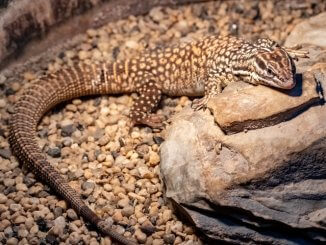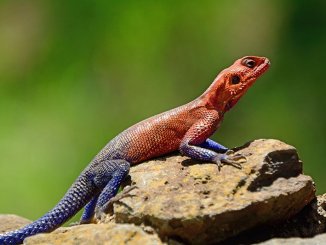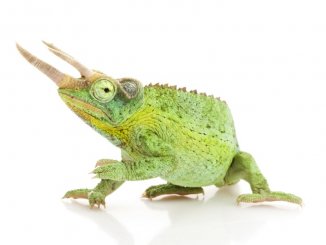An emerald swift is a vibrant green arboreal lizard with blue patches along its stomach. Emerald swifts are known for their spiny appearance due to the green plates that cover their bodies.
The emerald swift lizard is natively found in the rain forests of Central America where it feeds on insects and spiders, and prefers to bask in the sun.
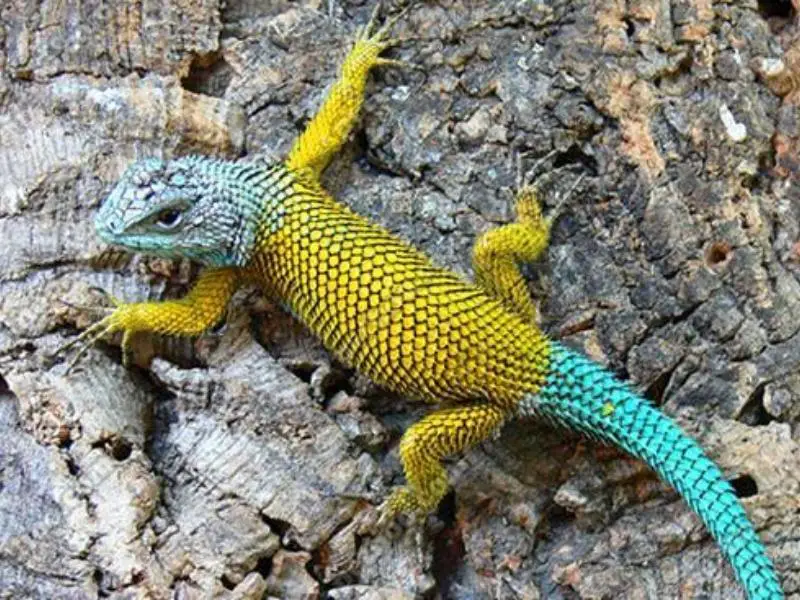
Emerald swifts are popular terrarium display pets and fairly easy to care for once the correct environment is created. By maintaining the right temperature and humidity conditions, emerald swifts easily adapt to their captive environment.
Emerald Swift Overview
| Common Name: | Emerald swift, green spiny lizard |
| Scientific Name: | Sceloporus malachiticus |
| Natural Habitat: | Mountain, rainforest, and woodland habitats in Belize, Costa Rica, El Salvador, Guatemala, Honduras, Mexico’s Yucatán region, Nicaragua, and Panama |
| Adult Size: | 6–8 inches |
| Average Lifespan: | 5–10 years |
| Diet: | Insectivorous |
| Housing: | Minimum enclosure of 20 gallons for a single adult with full spectrum lighting for 12–14 hours a day; the ambient day temperature of 75–80˚F and night temperature at 70˚F or more; basking temperatures of 90–95˚F |
| Experience Level: | Intermediate |
Origin
The emerald swift (Sceloporus malachiticus) is native to the tropical and subtropical woodlands and cloud forests from southern Mexico to Panama.
These lizards share the same body shape and spiny texture on their scales as the fence lizards that are common throughout the southern US.
Emerald swifts are active and move fast, but they prefer to bask in the sun after they’ve hunted for insects in the morning.
If the day becomes too hot or the lizard feels threatened, the emerald swift retreats higher up in trees or hides under rocks, in burrows, or logs. Emerald swifts retreat at nighttime to sleep.
Emerald swifts are common in the exotic pet trade, and most adults are wild-caught and then sold.
Most emerald swifts aren’t tame lizards, so in captivity, they are more often kept as display reptiles rather than as pets to handle.
Appearance and Behavior
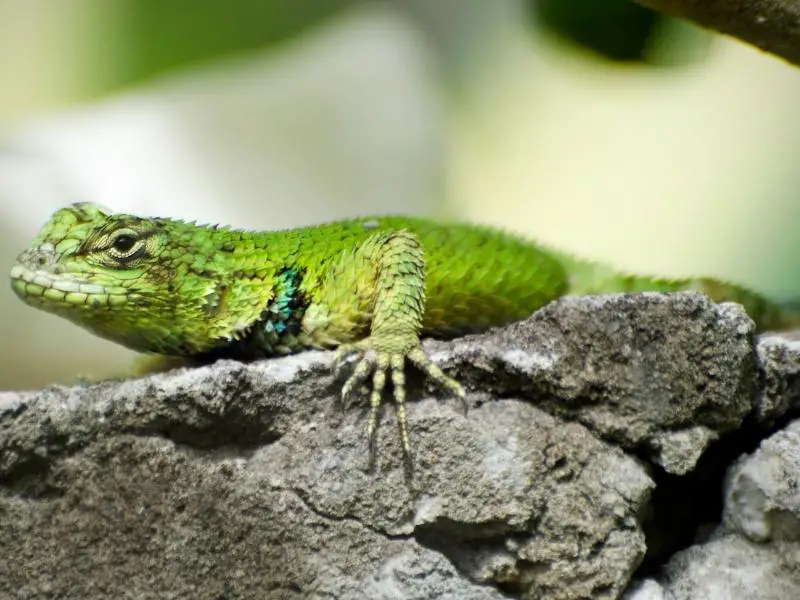
As the emerald swift’s name indicates, this lizard is a vibrant emerald green color.
The male lizards have some variation of blue shading on either side of their bellies, while the female emerald swift can be brown to emerald with darker spots.
The emerald swift has a compact body with noticeably long toes, a slender tail, and a blunted head. Emerald swifts have an armored appearance due to the stiff and pointy scales that cover their bodies.
Emerald swifts are diurnal, meaning they are active during the day. In the late afternoon, they look for a safe place to spend the night.
Size and Lifespan
Emerald swifts grow to between 6–8 inches in length from nose tip to tail tip as adult lizards. The adult males are typically larger than the female emerald swifts.
Most emerald swifts enter the pet trade as adults, so it’s difficult to determine an accurate lifespan.
If the lizard is well cared for and acclimated well to life in captivity, it may easily live up to five years. Emerald swifts born in captivity live a decade on average.
Temperament
As with most lizards and iguanas, emerald swifts prefer a quiet environment. The lizard may become stressed when startled by sudden movements and sounds, like when a predator approaches.
When housing emerald swifts together, be sure to house a male and a female together and not two males because males are quite territorial. Male emerald swifts fight if forced into the same enclosure.
Since emerald swifts are usually wild caught, they aren’t domesticated and don’t enjoy being handled. Being forced to accept human contact can lead to biting and flighty behavior.
Housing Emerald Swifts
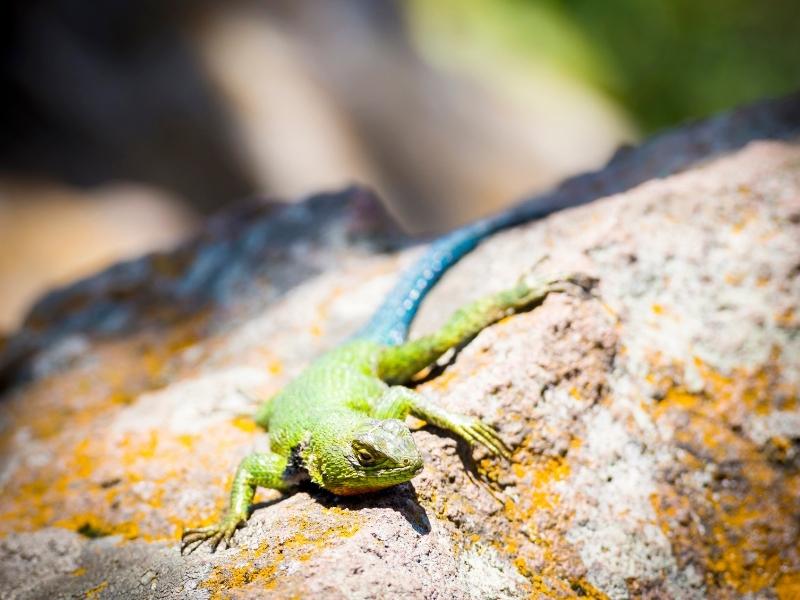
Emerald swifts are arboreal, and while they require basking rocks, they also enjoy a terrarium with decorations that simulate their wild forests.
Enclosure Size
A 20-gallon terrarium is ideal for a single emerald swift. If housing two emeralds together, increase the tank size by at least two to three times because these active lizards enjoy the space to roam and scurry.
An enclosure size of 36 inches long, by 18 inches wide, and 18 inches tall is preferred.
A long, narrow terrarium provides the perfect space to decorate like the lizard’s wild habitat: the length allows for tree limbs, there is sufficient height for plants, and enough floor space for basking rocks or a heating pad.
Make the tank bigger depending on how many plants and other decorations you add. Be sure to add a screen lid to keep your emerald greens inside, because they will happily climb up to the edge of the terrarium and can escape if a branch gives them access.
Lighting
Meet the basking needs of the emerald swift by using a UVB bulb in a reflective fixture, a daylight-spectrum lamp, and a halogen heating lamp.
The halogen heating lamp reduces overheating, while imitating the sun’s warmth in an indoor environment.
Correct lighting is needed to ensure the emerald swift can make enough vitamin D3, which leads to correct bone growth.
In a tank without correct lighting, the emerald swift will soon develop abnormal bone growth or weakened nails. A lack of vitamin D3 can negatively affect the lizard’s ability to climb.
Use mercury bulbs that offer stable UVB light to the enclosure. Place these lights on a timer when you aren’t home to look after your emerald green, to keep lighting regular.
Set your lighting to 11 hours of light during the winter and 12 hours of light during the summer. This is most similar to the natural light availability in the tropical rainforests of the green emerald’s natural habitat, and will help regulate the lizard’s hormone cycles.
The basking light should be placed 11–12 inches above the basking area for increased heat and light.
Temperature and Humidity
The emerald swift’s terrarium should be set up with two temperature zones. The cooler, “forest” area should have an ambient temperature of 75˚F and should be decorated with branches for the lizard to climb and large rocks to hide between.
The basking area should have a warmer temperature of 80˚F. At night, when the lighting is switched off, the tank temperature can drop, but it shouldn’t drop lower than 68–69˚F. In cold climate zones, an all-night heating pad is needed to maintain the right temperature ranges.
Mist your emerald swift daily, and mist the plants and branches to increase the humidity of the terrarium and prevent unnecessary shedding.
Use a hygrometer to check that the humidity of the enclosure always ranges between 60% and 80%—think tropical rainforest. The emerald swift needs a “sticky” humidity zone that is clammy, but not wet.
Be sure to position your hygrometer in the middle of the terrarium to ensure you get an effective humidity reading.
Substrate and Decoration
The substrate of the emerald swift’s terrarium should be soft to create a safe space for the lizard to land if it happens to slip off a tree branch. Cypress mulch and orchid bark builds humidity without becoming moldy.
Add in some green sphagnum moss for an even better humidity-building substrate. When misting the tank, the substrate will absorb excess water and release it as water vapor when heated by the heating pad. Layer the substrate three to four inches thick.
Give the emerald swift a place to bask by adding several large, flat stones. Alternatively, buy a synthetic basking rock that has the dimensions of a heating pad to help create the perfect basking spot.
Complete the rainforest environment with branches, green plants (fake or real), and logs that create an interesting area for the emerald swift to climb and explore. Real greenery such as anthuriums and ferns increases the humidity levels.
Lastly, add a large cave-like area for the emerald swift to retreat to at night. If you don’t have an artificial lizard cave, opt for some split bark logs that have natural openings where the emerald swift can hide.
Cleaning
Spot clean the terrarium daily by wiping up water spills and urates, and removing feces. If the water bowl is dirty, wash it with a reptile-friendly disinfectant and rinse well before refilling it with fresh water for your emerald swift. Check for mold buildup among plants and on the walls.
Deep clean the terrarium once or twice a month. Gently remove your emerald swift from the enclosure and place it in a secure temporary container. Then remove everything from the terrarium.
Soak the decor in a 5% bleach solution and rinse well. Wash the water bowl in the reptile-safe disinfectant, rinse well, and let it air dry.
Remove and throw away the substrate. Wash the inside and outside of the terrarium with hot water and a 10% bleach solution. Rinse the enclosure and allow it to dry thoroughly before adding new substrate, decorating the terrarium, and replacing the water bowl and your emerald swift inside.
Emerald Swift Care
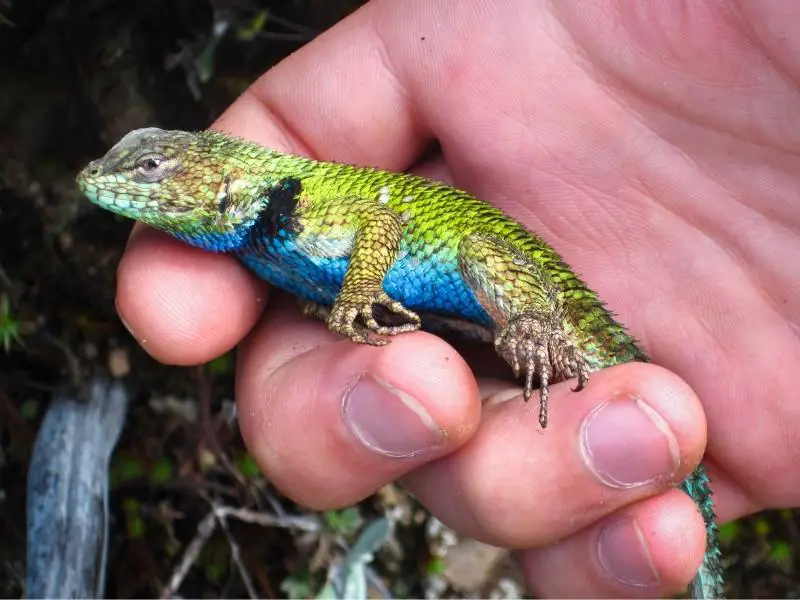
Emerald swifts require an intermediate level of care. Ensure these lizards eat only appropriately-sized insects, have access to clean water, and get calcium and a vitamin supplement with every feeding. Take care when handling the flighty and sometimes aggressive emerald swift.
Food and Water
Emerald swifts are insectivores, so feed them a varied diet that includes some of the following options: mealworms, mealworm beetles, hornworms, dubia, discoid, red runner roaches, waxworms, black soldier fly larvae, crickets. The insects should be no larger than the size of the space between the lizard’s eyes.
Adults should be fed every other day, as many insects as they can eat in 15 to 20 minutes. Juvenile emerald swifts should be fed twice every day. Remove any excess insects that the adult or juvenile lizard doesn’t eat in the 15–20 minutes to ensure your emerald swift doesn’t become obese.
The emerald swift needs clean drinking water in a large, shallow bowl. The large surface of the bowl helps increase humidity in the terrarium. Fresh water should be given to the emerald swift every day, and the bowl needs to be washed weekly or when it’s dirty with a reptile-safe disinfectant.
Aside from the fresh standing source of water, the emerald swift also needs to be misted twice a day with room temperature water.
Handling
You can gently and briefly handle the emerald swift but only when needed, such as for terrarium cleaning or maintenance, or during the lizard’s physical exam. Excess handling will stress the emerald swift.
The emerald swift is an agile and quick lizard, and when you restrain it, the lizard squirms and wriggles to get away. When you need to handle your lizard, ensure the emerald swift can’t escape your hands. Aggressive emerald swifts may also bite you, so follow these guidelines for the best handling experience for you and your lizard:
When you absolutely need to handle your emerald swift, slowly approach it and slide your hand under its belly. Form a “cage” with your other hand over the top of the lizard to gently but securely hold it. Wash your hands after handling the emerald swift to prevent Salmonella infections.
Common Health Issues
One of the most common health issues with emerald swifts is bone deformation as a result of poor lighting conditions. When the emerald swift doesn’t receive enough radiant energy from its basking area, the lizard’s body won’t produce sufficient vitamin D3, and the lizard’s bones will become deformed and soft.
A good cure for swollen legs and limbs from vitamin deficiency is to replace your UVB bulb with a better-quality product to help increase the emerald swift’s vitamin uptake and synthesis.
Other health issues include:
- Runny tummy: When a bacterial infection has caused poor digestion, consult with your vet as specialized medication is needed
- Respiratory disease: Lizards like the emerald swift should have clear nasal passages, and they should breathe evenly. If your emerald swift suddenly has labored breathing, consult with your vet, as labored breathing may be a sign of respiratory disease. Respiratory diseases are often caused by too-high temperatures or too-high humidity in the terrarium. As well as contacting your vet, adjust the tank conditions and check whether your thermometer is still working accurately
- Sores on the skin: Body sores are often the result of an unsuccessful attempt to shed. It may be that the tank conditions aren’t conducive to shedding. Increase the humidity and provide a bathing area where the emerald swift can wash, which will soften the skin that is ready to be shed. Add a shedding box layered with moss to help loosen the old skin and assist in the shedding process
Supplement Requirement
A dietary supplement with calcium and vitamin D3 is essential with every feeding to prevent the emerald swift from developing a nutrient deficiency that may lead to metabolic bone disease.
Supplements come in a powder form that you can dust onto the prey before feeding them to the emerald swift. Alternatively, opt for a reptile multivitamin to give to your emerald swift weekly.
Breeding
To breed emerald swifts, set up a large tank decorated with many branches. Humidity should be 60%–70% at all times to ensure the soil is moist.
The night temperatures need to be cooler, while the temperature and basking areas should be the same as for a non-breeding tank.
Place at least one breeding pair in the tank, or several females with one male. Placing multiple males together in a tank can lead to aggression and territorialism.
Once the conditions in the tank are right, the male will start courting the female, engaging in species-specific head bobs that are accompanied with tail licking, head butting, and a slow-circle mating dance. During copulating, the male bites the female on the shoulder.
The gravid female emerald swift swells with pregnancy, and you’ll be able to see the babies moving around through the gravid female’s belly skin as she nears delivery.
Emerald swifts are ovoviviparous, giving birth to 6–15 juveniles at a time. They prefer to give birth in an area that’s hidden by branches.
Feed the juveniles small insects twice a day, and ensure their enclosure is kept humid by misting the tank daily.
Choosing and Buying an Emerald Swift
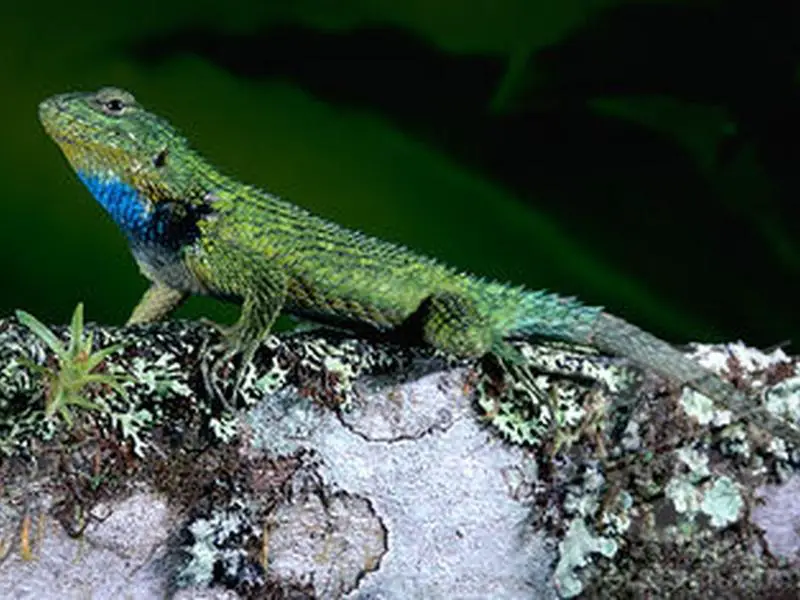
Most emerald swifts are wild caught, and while breeding is possible in captivity, it is often not feasible or as profitable as purchasing the lizards.
When purchasing emerald swifts, be sure to check whether the dealer has a valid importer’s license and whether your state requires you to have a license to keep a lizard.
Since any lizard can carry salmonella, it is a good idea to check whether the lizards you plan to buy have been vet-checked, and are licensed as a safe species by your local parks and wildlife.
If you choose to purchase a domestically bred emerald swift, be sure to inspect the breeding setup. Does the breeder meet all of the requirements for keeping and breeding emerald swifts?
If they don’t, you run the risk of purchasing a sickly emerald swift.
Once you have selected a breeder or importer to purchase from, examine the lizards yourself. Are the lizards healthy-looking, or do they have swollen limbs and broken toenails?
Expect to pay from $24 to over $100 for an emerald swift lizard. The wide price fluctuations depend on the lizard’s coloring, age, and size.
Juvenile emerald swifts cost less, while the more vibrantly colored emerald swifts fetch a higher price. Specials are often available for a group or matched breeding pair.

